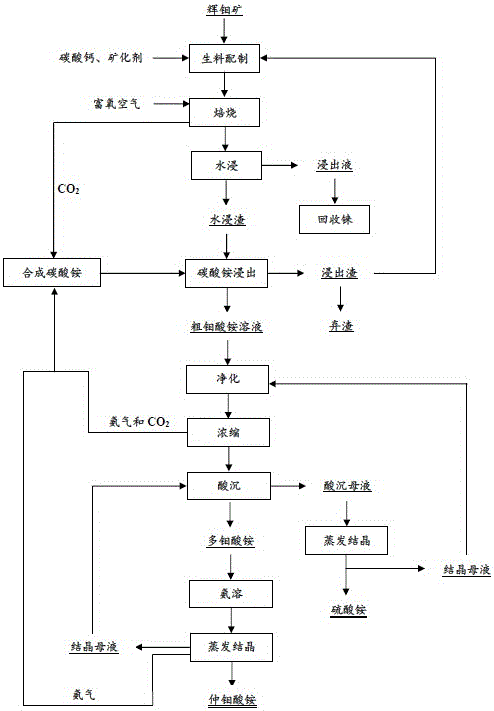A kind of method for preparing ammonium molybdate by molybdenite
A technology of molybdenite and ammonium molybdate, which is applied in the field of molybdenum smelting, can solve the problems of refractory acid-containing wastewater, increased treatment costs, serious equipment corrosion, etc., achieve low equipment requirements, reduce waste residue and wastewater discharge, and reduce environmental pollution small effect
- Summary
- Abstract
- Description
- Claims
- Application Information
AI Technical Summary
Problems solved by technology
Method used
Image
Examples
Embodiment 1
[0039] Example 1: Press CaCO 3 / MoS 2 The molar ratio is 3.6. Calcium carbonate, a certain molybdenite (the mass percentage of Mo is 40.33%) and 3% calcium fluoride are ground and mixed to obtain a raw meal. The raw meal size D90 is 110 μm. Then, the raw meal is roasted in an oxygen-rich atmosphere at 600° C. for 2 hours in a roasting furnace to obtain clinker. After the clinker is cooled to room temperature, it is finely ground with a vibration mill, and the clinker particle size D90 is 130 μm. After the clinker is leached with water, solid-liquid separation is performed, and rhenium is recovered from the leachate. The leaching residue after water leaching is added to a stirred leaching tank, leached with an ammonium carbonate solution with a concentration of 800g / L, and reacted at 100°C for 4 hours. After the reaction, the leaching pulp is vacuum filtered, and the filter cake is washed three times with pure water. The molybdenum leaching rate in molybdenite is 98.12%. Afte...
Embodiment 2
[0040] Example 2: Press CaCO 3 / MoS 2 The molar ratio is 3.0. Calcium carbonate, a certain molybdenite (the mass percentage of Mo is 40.33%) and 2% calcium fluoride are ground and mixed to obtain a raw meal. The raw meal size D90 is 100μm. Then, the raw meal is roasted in an oxygen-rich atmosphere at 600°C for 0.5 hour in a roasting furnace to obtain clinker. After the clinker is cooled to room temperature, it is ground with a vibration mill, and the clinker particle size D90 is 70 μm. After the clinker is leached with water, solid-liquid separation is performed, and rhenium is recovered from the leachate. Add the leaching residue after water leaching into a stirred leaching tank, leaching with an ammonium carbonate solution with a concentration of 300g / L, and reacting at 90°C for 6 hours. After the reaction, the leaching pulp is vacuum filtered, and the filter cake is washed three times with pure water. The molybdenum leaching rate in molybdenite is 75.61%. Then, similar to...
Embodiment 3
[0041] Example 3: Press CaCO 3 / MoS 2 The molar ratio is 5.0. Calcium carbonate, a certain molybdenite (the mass percentage of Mo is 40.33%) and 10% calcium fluoride are ground and mixed to obtain a raw meal. The raw meal size D90 is 80 μm. Then, the raw meal was baked in a roasting furnace with air and roasted at 400°C for 6 hours to obtain clinker. After the clinker is cooled to room temperature, it is ground with a vibration mill, and the clinker particle size D90 is 70 μm. After the clinker is leached with water, solid-liquid separation is performed, and rhenium is recovered from the leachate. The leaching residue after water leaching is added to the leaching equipment, the leaching equipment is a leaching tank with stirring, leached with an ammonium carbonate solution with a concentration of 800g / L, and reacted at 70°C for 8 hours. After the reaction, the leaching pulp is vacuum filtered, and the filter cake is washed three times with pure water. The molybdenum leaching ...
PUM
| Property | Measurement | Unit |
|---|---|---|
| particle size | aaaaa | aaaaa |
| particle size | aaaaa | aaaaa |
| concentration | aaaaa | aaaaa |
Abstract
Description
Claims
Application Information
 Login to View More
Login to View More - R&D
- Intellectual Property
- Life Sciences
- Materials
- Tech Scout
- Unparalleled Data Quality
- Higher Quality Content
- 60% Fewer Hallucinations
Browse by: Latest US Patents, China's latest patents, Technical Efficacy Thesaurus, Application Domain, Technology Topic, Popular Technical Reports.
© 2025 PatSnap. All rights reserved.Legal|Privacy policy|Modern Slavery Act Transparency Statement|Sitemap|About US| Contact US: help@patsnap.com

